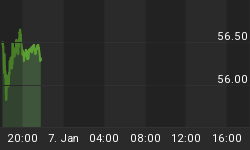The previously unloved energy sector has lately been hogging analysts' coverage thanks to a nice rebound in oil prices. However, it's the semiconductor sector that has been a true monolith of performance even in the current tepid and lackluster market that has remained largely indifferent to a strong earnings season.
The semiconductor sector has strong semiconductor chip prices to thank for the feat. Giant memory chip marker, Micron Technology (NASDAQ:MU), has however still managed to be outshine most, if not all, of its peers, out-classing the industry's most popular benchmark by a country mile with year-to-date returns of 45 percent vs. 9.5 percent by the iShares PHLX Semiconductor ETF (SOXX).
MU stock has more than doubled over the past 12 months.
Micron Stock vs. SOXX Year-to-Date Change

(Click to enlarge)
Source: CNN Money
Cyclical Upturn
Micron shares have surged 12 percent over the past two days after the company's management revealed plans to repurchase a whopping $10 billion of the company's shares or about 15 percent of the company's value starting 2019. Actually management was simply reiterating its 2017 pledge to return 50 percent of the company's free cash flow to investors in the form of dividend and share buybacks.
The fact that a company that just three years ago was hanging precariously in the balance is now about to become a broken slot machine is a true testament of how quickly fortunes can change in the semiconductor industry.
Micron is enjoying the rub of the green from a nice cyclical upturn in the DRAM memory market where tight supply has helped goose prices. As a result, Micron's top line has expanded by at least 50 percent over the past four consecutive quarters. Related: The ‘Wolf of Wall Street’ Is A Multi-Million-Dollar Deadbeat
PC DRAM prices are expected to improve a further 3 percent during the second quarter after a 5-percent increase during the first quarter and a humongous 40-percent growth in 2017.
Despite concerted efforts to shift to NAND, DRAM remains Micron's main cash cow bringing in more than 60 percent of its revenue. Micron is the world's third-largest DRAM supplier with 21-percent market share behind only Samsung and SK Hynix. DRAM is a memory architecture that's used in PCs, servers, mobile devices and graphics.
Stodgy memory segments like DRAM and NAND do not ordinarily attract as much media attention as sexier GPUs by companies like Nvidia (NASDAQ:NVDA) and Advanced Micro Devices (NASDAQ:AMD); but the industry has been surpassing even the wildest expectations this time around.
Prices of mobile DDR in particular have gone through the roof over the past two years.
At first, this might seem counterintuitive given the backdrop of weak smartphone demand and high DRAM inventory levels by smartphone manufacturers. The main crux of the matter has, however, been that all the three major DRAM manufacturers have been cutting back on their capital investments and any new fab expansions are expected to take years to come online. DRAM wafer starts at the three companies is expected to grow just 5-7 percent in 2018 with DRAMexchange predicting that industrywide capacity growth will come in at a near-historic low of 19.8 percent in 2018.
Can the Bounty Last?
Of course the question at the top of the minds of many Micron investors is for how long the company can remain on the catbird seat. Specifically, when will Micron's DRAM money machine run dry?
The memory market operates on boom and bust cycles that usually last several years. The current uptick is actually a supercycle that has seen one of the biggest price expansions in recent memory. But there are already signs of things cooling off with DRAM price growth starting to moderate.
Meanwhile, prices of NAND flash, another important Micron product, are beginning to fall slightly due to building oversupply. That's not good news because this is happening at a time when Micron is preparing to start shipping the world's highest density 3D NAND flash memory chip that it has co-produced with Intel Corp.(NASDAQ:INTC).
Word of advice: enjoy the fat dividends and copious buybacks now until the inevitable reversion to pragmatism kicks in.
By Alex Kimani for Safehaven.com
More Top Reads From Safehaven.com:
















